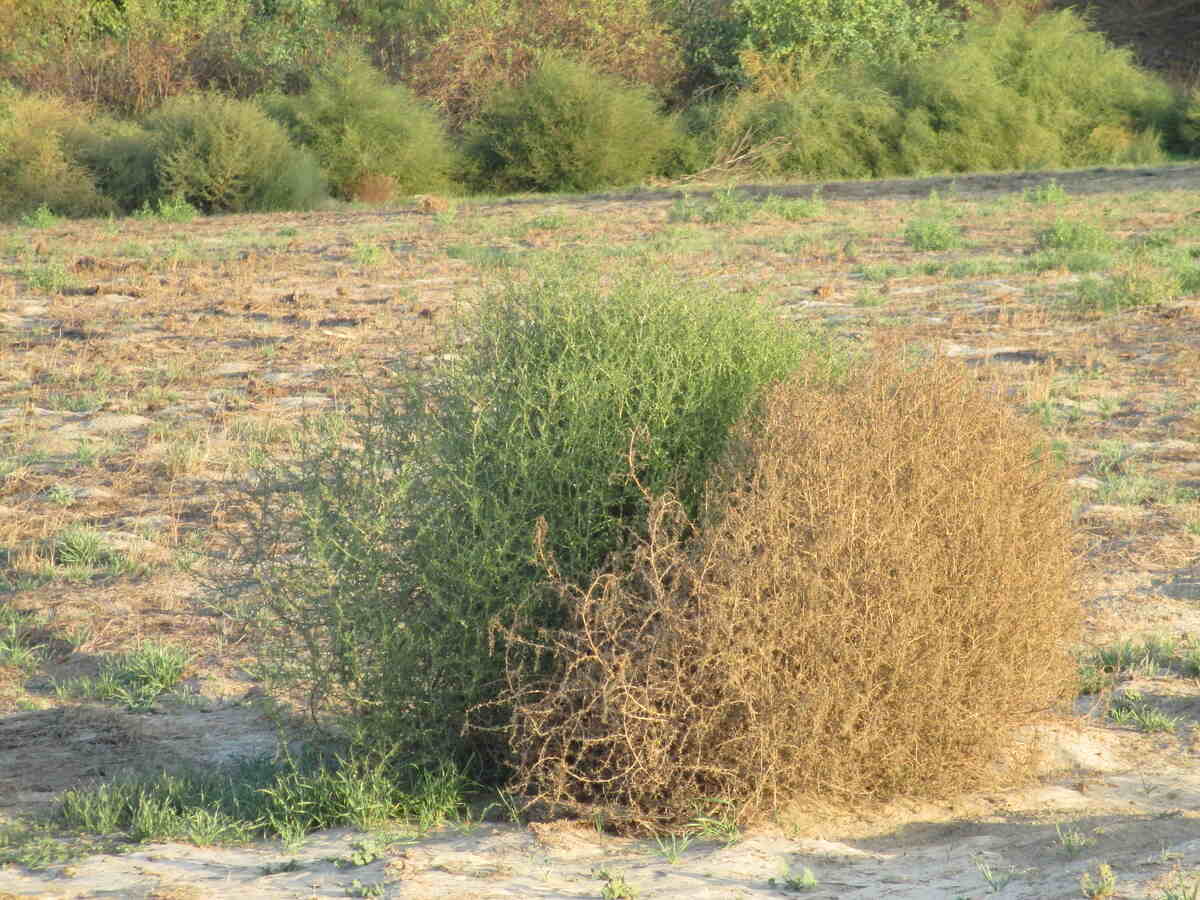
“Deep in my heart is a song,
Here on the range, I belong,
Drifting along with the tumbling tumbleweeds.”
Sons of the Pioneers, the group that launched Roy Rogers’ career, wrote a song about tumbleweeds and helped inspire our iconic view of the Old West. If you’re curious to know more, saddle up! We’ll explain their origins, how they spread, how to control them, and much more. Here’s everything you need to know about tumbleweeds.
What Are Tumbleweeds?
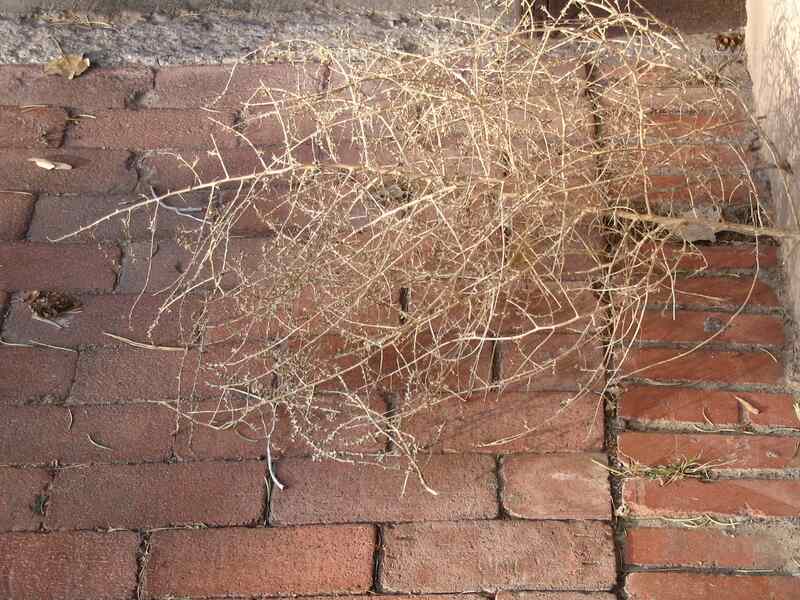
Tumbleweeds are various plants that, once mature, dry out, detach from the root and are gone with the wind. While many tumbleweed species exist, the Russian thistle (Salsola tragus) is the best known. Bright green and succulent when growing, it develops reddish or purple shoots and green flowers surrounded by prickly bracts.
Tumbleweeds are annual plants. The seeds germinate in the spring, flower in the summer or fall (depending on the species), and reproduce only by seed. Unlike other weed seeds, which can live for decades, most tumbleweed seeds remain viable for only one year (though some live up to three years).
Small rodents and antelope might eat the tender shoots. Still, once the tumbleweed plant has dried to a skeletonized ball of branches, it rarely becomes the breakfast of animals. During the Dust Bowl period in the 1930s, it was used as forage hay out of desperation when grasses failed.
Tumbleweed facts: Tumbleweeds are not only a group of plants, but “tumbleweed” also refers to a process of seed dispersal adopted by multiple species of unrelated plants.
Origin of Tumbleweeds in the U.S.
Early species of tumbleweeds are not a native part of the landscape of the American West as much as old Westerns might make you think. They are invasive plants that hitchhiked to the United States with imported flax seeds during the 1870s. The spread of the Russian thistle resulted in one of the fastest plant invasions in American history.
“The seeds arrived in grain imported from Russia (eastern Asia) by immigrant farmers in the western United States,” says David Salman, Chief Horticulturist for High Country Gardens in Santa Fe, New Mexico.
In 1881, the county of Bon Homme, South Dakota, gave the United States Department of Agriculture its first note of concern about tumbleweeds. Tumbleweeds had reached the California coast by 1895. These shrubby plants excelled at one thing — seed dispersal.
The Weed That Seeds
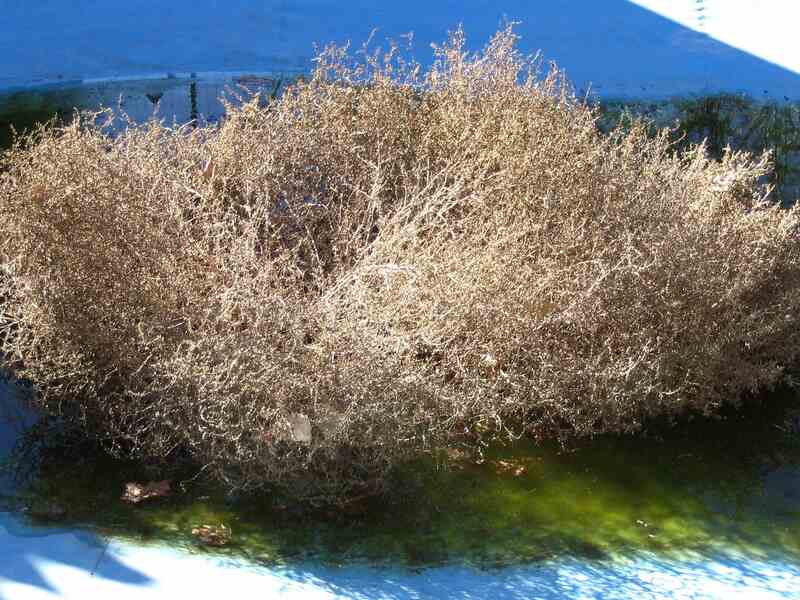
The absence of a protective layer distinguishes the seeds. Each seed includes an embryonic plant wrapped in a thin membrane. They remain dormant until the weather warms up again.
The plant is ready to uncoil and germinate once it has absorbed water. It quickly sprouts two needle-like stalks and grows, grows, grows. By the fall, the plant has reached maturity, blossomed, and begun to dry out. Then, the tumbleweed life cycle starts again.
- Russian thistle seedlings thrive in loose, plowed, or eroded soil conditions, for example, those found on farms or along highway roadsides.
- A specific layer of cells allows for the easy separation of plant and root.
- As tumbleweeds tumble, they disperse seeds. One plant can spread approximately 250,000 seeds per winter.
The Tumbleweed Travels
Tumbleweeds sprouted quickly when the early farmers planted the infected grain, thriving in cleared areas of land and surviving on very little water. They had few predators and offered little to farmers as a viable crop. Russian thistle also contains nitrates and soluble oxalates in levels that are poisonous to sheep.
“Since the plant did not appear in North America until the 1870s, Native Americans have had relatively little time to discover a use for it,” says Lincoln Smith, research entomologist at the U.S. Department of Agriculture’s Agricultural Research Service (USDA ARS). “Cattle will graze it when the plants are young (before the leaves get spiny).”
In 1894, the USDA dispatched botanist Lyster Hoxie Dewey to investigate. He reported that the weed posed an existential threat to farms. “Spreading rapidly as it is over new territory and becoming more destructive in the region already infested, it threatens serious consequences unless prompt measures are taken to subdue it.”
Tumbleweed plants have spread across the United States, including Alaska, Hawaii, and southern Canada. They extend from China to the majority of Europe and North Africa. It has also reached parts of Southern Africa, Australia, and Central and South America.
The Dangers of Tumbleweeds
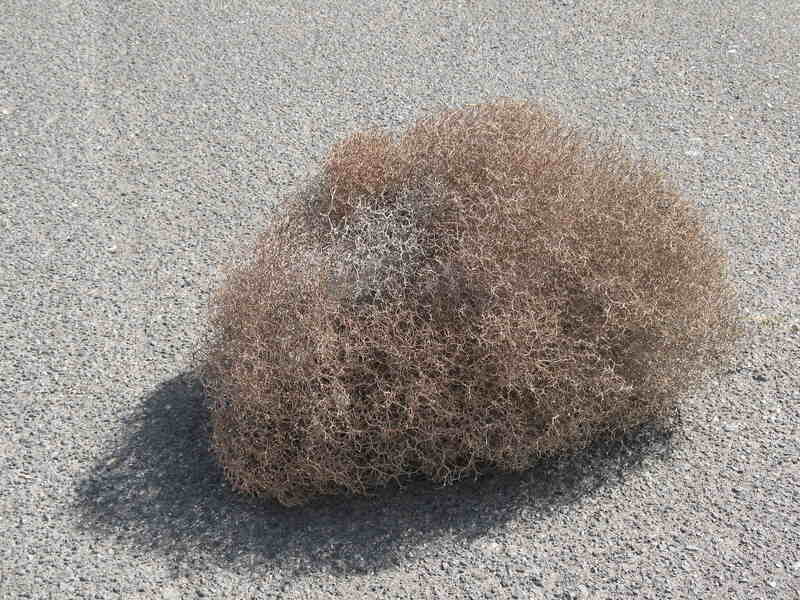
Are tumbleweeds dangerous? Yes. Tumbleweeds are not only a prickly nuisance to snag your clothes and scratch your car, but these rolling balls of chaos can cause other problems.
- Pest problems: “In California’s Central Valley, tumbleweeds aid several insect pests of many vegetable crops like the beet leafhopper, Say’s stink bug, and lygus bug because these insects feed on tumbleweed in the late summer, when there is nothing else to feed on,” says Smith.
- Fire hazards: Tumbleweed stems can burn quickly and get remarkably hot because of their light, airy structure. They are a severe risk for spreading wildfires.
- Allergic reactions: Some people are allergic to the pollen and sap of Russian thistle. The pointy tips can puncture the skin of humans and animals and cause dermatitis or infection.
- Disrupt ecosystems: Tumbleweeds are a highly invasive species. Due to turned-over soil from road grading, they will undoubtedly take over the area, displacing native plants and animals.
- Harm crops: Tumbleweeds are a nuisance to agriculture because they deprive crops of water and act as a breeding ground for damaging insects and pathogens.
When Tumbleweeds Attack
So, what are tumbleweeds good for? Nothing. Tumbleweeds are useless to farmers and ranchers, and the rolling plants can sometimes be a hazard. They pile up against fence gates, buildings, vehicles, or each other. The skeletal remains of Russian thistle may become tangled in electrical lines and clog water treatment plants.
“Tumbleweeds are primarily a problem where the soil has been severely disturbed by construction, poor farming practices, and road building,” says Salman. ”It is a pioneer plant that thrives in conditions too hot and dry for most plants to grow. Generally, this weed is a nuisance. It can pile up sometimes along walls and fence lines of 6 feet or deeper.”
- In 1989, Mobridge, North Dakota, had to call equipment operators to remove tumbleweeds that buried homes and created fire hazards.
- In 2018, overgrown areas of tumbleweeds overcame the town of Victorville, Calif.
- New Year’s Eve in 2019: In an incident dubbed “Tumblegeddon,” Washington State troopers had to spend 10 hours unearthing cars and a semis from behind tumbleweed mountains that had swamped a road.
Other Tumblers
Other species of tumbleweeds found in North America have formed hybrids with the Russian thistle (Salsola tragus):
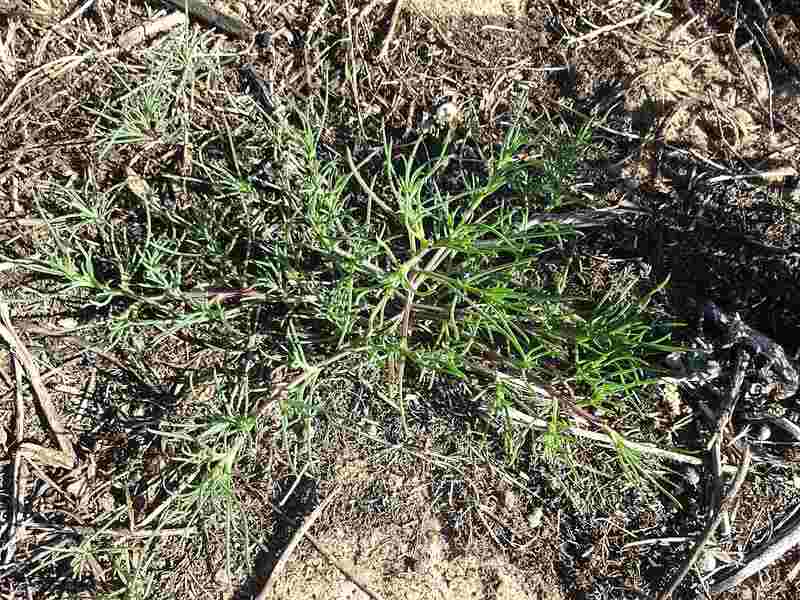
- Barbwire Russian thistle (Salsola paulsenii) is found in desert areas. Sand usually anchors down this tumbleweed variety, preventing it from tumbling. The seeds detach and get scattered by wind gusts.
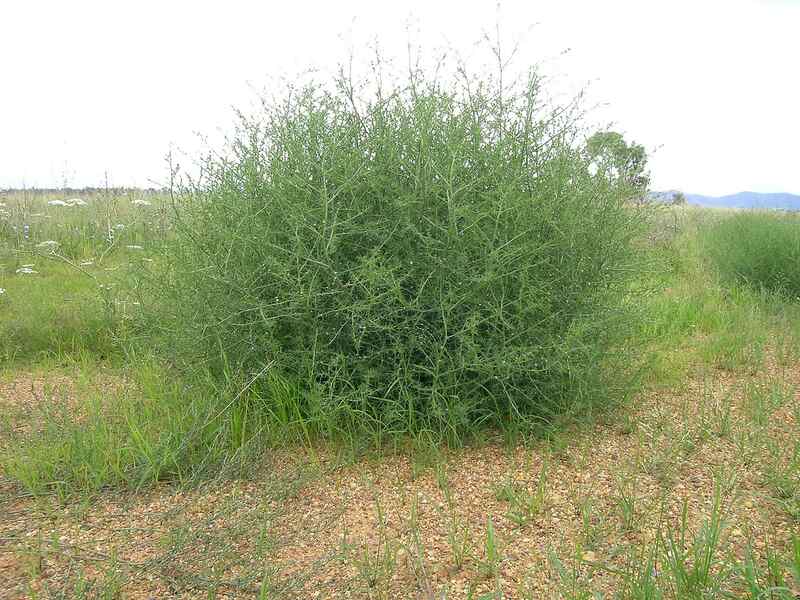
- Prickly Russian thistle (Salsola australis) is native to Australia. It thrives in California, Arizona, Texas, and Hawaii. ”It typically does not tumble, and the seeds easily blow off the plant,” says Smith. “Its first appearance in California was probably in the 1980s and is likely still spreading.”
- Salsola gobicola (a polyploid hybrid of S. tragus and S. paulsenii) is found mainly in the western U.S. and central Asia. It is common in California’s sandy regions. The leaves have an opposite to alternate leaf arrangement on the stem and range in color from gray-green to yellow-green. The flowering season lasts from July to October.
- Salsola ryanii (a polyploid hybrid of S. tragus and S. australis) has intermediate characteristics of the two “parental’” species. It grows later than the other species of tumbleweed. It uses summer rain and climate changes to grow faster and range farther than the others. It also gets larger — up to 6 feet across.
Like Dewey, more than a century before, scientists in recent years have sounded the alarm about this new hybrid, salsola ryanii. The University of California wrote a news story in 2019 about ryanii titled: “Monster Tumbleweed: Invasive New Species is Here to Stay.”
Tumbleweed Control
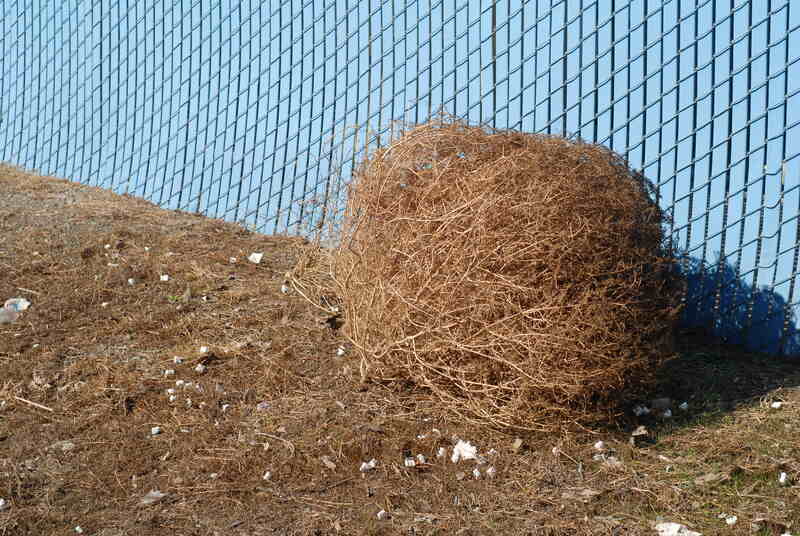
Smith and researchers at the USDA AGR are working on discovering and evaluating possible biological control agents for the Russian thistle. A 2014 study uncovered two fungal pathogens that may help. Infected plants in Russia and Hungary both contained the same pathogens.
Although they eliminated Russian thistle from sites in only two seasons, approval for using the pathogen has rolled more slowly than the invasion of the plant on land in the Western states. Methods for controlling Russian thistle include:
- Destroy young plants: The best control method is mowing or pulling up Russian thistle plants before they can seed and become the next horror movie.
- Avoid breaking up soil: Russian thistle seedlings need loose soil to grow, so do not till or disturb the ground in unused areas.
- Plant the competition: Russian thistle rarely causes issues in well-managed gardens, turfgrass, or landscapes and competes poorly in environments with firm, frequently irrigated soil.
- Burn accumulated weeds: This will remove the debris, but most of the seeds have already spread.
CAUTION: Russian thistle is highly flammable when dry and can start a wildfire if mishandled.
- Use an herbicide: Some weed killers, including glyphosate, might work if applied to plants before drying up and tumbling away; however, glyphosate, the active chemical in Roundup and other weed-killers, has environmental concerns.
FAQ About Tumbleweeds
How Do Tumbleweeds Affect the Environment?
Tumbleweeds are highly invasive and spread quickly.
- They can damage ecosystems and out-compete desirable plants.
- Tumbleweeds damage property.
- They’re a fire hazard and a host for pests.
Can You Make a “Snowman” Out of Tumbleweeds?
Yes! However, you probably shouldn’t. By the time you’ve rolled, stacked, and decorated your prickly snowman, you’ve succeeded in reseeding your lawn with Russian thistle. Also, tumbleweeds are highly flammable, making frosty a fire hazard.
The Albuquerque Metropolitan Arroyo Flood Control Authority has a yearly tradition of displaying a tumbleweed snowman. He stands 12 to 14 feet tall, 8 feet wide, and is only three tumbleweeds. His ornaments come from recycled materials.
Are Tumbleweeds Good For Anything?
The thin leaves of the Russian thistle can provide forage for some herbivores, but it is an invasive and noxious weed. The fully-grown Russian thistle is poisonous to animals and unsafe to eat. Apache pocket mice and Gambel’s quail in White Sands National Park eat tumbleweed seeds.
When to Call a Professional
Maintaining your lawn is the best way to fend off weeds. However, mowing and fertilizing, plus wrangling tumbleweeds, are challenging tasks. Contact a local lawn care pro today if you’d prefer to watch the tumbleweeds roll through your favorite Western movie rather than your front yard. Just schedule your lawn care and grab the popcorn.
Main Image Credit: nccmrm97 / Flickr / CC BY-SA 2.0